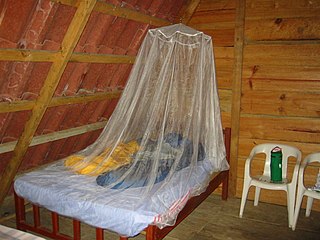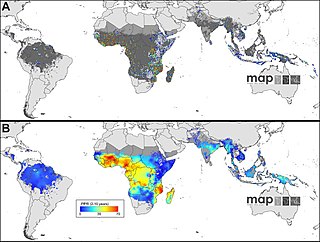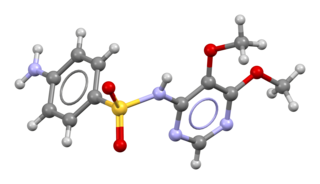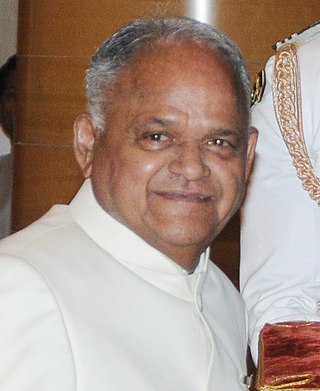
Tonic water is a carbonated soft drink in which quinine is dissolved. Originally used as a prophylactic against malaria, nowadays tonic water usually has a significantly lower quinine content and is often sweetened. It is consumed for its distinctive bitter flavor and is frequently used in mixed drinks, particularly in gin and tonic.

Mefloquine, sold under the brand name Lariam among others, is a medication used to prevent or treat malaria. When used for prevention it is typically started before potential exposure and continued for several weeks after potential exposure. It can be used to treat mild or moderate malaria but is not recommended for severe malaria. It is taken by mouth.

Artemether is a medication used for the treatment of malaria. The injectable form is specifically used for severe malaria rather than quinine. In adults, it may not be as effective as artesunate. It is given by injection in a muscle. It is also available by mouth in combination with lumefantrine, known as artemether/lumefantrine.

A mosquito net is a type of meshed curtain that is circumferentially draped over a bed or a sleeping area, to offer the sleeper barrier protection against bites and stings from mosquitos, flies, and other pest insects, and thus against the diseases they may carry. Examples of such preventable insect-borne diseases include malaria, dengue fever, yellow fever, zika virus, Chagas disease and various forms of encephalitis, including the West Nile virus.

Malaria culture is a method for growing malaria parasites outside the body, i.e., in an ex vivo environment. Although attempts for propagation of the parasites outside of humans or animal models reach as far back as 1912, the success of the initial attempts was limited to one or just a few cycles. The first successful continuous culture was established in 1976. Initial hopes that the ex vivo culture would lead quickly to the discovery of a vaccine were premature. However, the development of new drugs was greatly facilitated.

The Journal of Clinical Microbiology is a monthly medical journal published by the American Society for Microbiology. The journal was established in 1975. The editor-in-chief is Alexander J. McAdam. It is a delayed open access journal. Full text content is available free after a six-month embargo.

The Malaria Atlas Project (MAP) is a nonprofit academic group led by Peter Gething, Kerry M Stokes Chair in Child Health, at the Telethon Kids Institute, Perth, Western Australia. The group is funded by the Bill and Melinda Gates Foundation, with previous funding also coming from the Medical Research Council and the Wellcome Trust. MAP aims to disseminate free, accurate, and up-to-date information on malaria and associated topics, organised on a geographical basis. The work of MAP falls into three areas:
Butajira is a town and separate woreda in central Ethiopia. Located at the base of the Zebidar massif in the East Gurage Zone of the Central Ethiopia Regional State, Butajira has an elevation of 2131 meters above sea level. It is surrounded by Meskan woreda. It was part of former Meskanena Mareko woreda.
Artesunate/amodiaquine, sold under the trade name Camoquin among others, is a medication used for the treatment of malaria. It is a fixed-dose combination of artesunate and amodiaquine. Specifically it recommended for acute uncomplicated Plasmodium falciparum malaria. It is taken by mouth.

Sulfadoxine is an ultra-long-lasting sulfonamide used in combination with pyrimethamine to treat malaria.

Anopheles dirus is a vector of malaria in Asian forested zones.
The mainstay of malaria diagnosis has been the microscopic examination of blood, utilizing blood films. Although blood is the sample most frequently used to make a diagnosis, both saliva and urine have been investigated as alternative, less invasive specimens. More recently, modern techniques utilizing antigen tests or polymerase chain reaction have been discovered, though these are not widely implemented in malaria endemic regions. Areas that cannot afford laboratory diagnostic tests often use only a history of subjective fever as the indication to treat for malaria.

The Journal of Antimicrobial Chemotherapy is a peer-reviewed medical journal which covers antimicrobial chemotherapy, including laboratory aspects and clinical use of antimicrobial agents. It is published by Oxford University Press on behalf of the British Society for Antimicrobial Chemotherapy and was established in 1975. In January 2015 J. Peter Donnelly became the eighth editor-in-chief replacing Alan P. Johnson. The journal has had two previous publishers. All content is available for free after 12 months while authors also have the option to have their articles published immediately as open access.
BMJ Open is a peer-reviewed open access medical journal that is dedicated to publishing medical research from all disciplines and therapeutic areas. It is published by BMJ and considers all research study types, from protocols through phase I trials to meta-analyses, including small, specialist studies, and negative studies.
The Amazon Malaria Initiative (AMI) was a regional program that was created in 2001 by several countries sharing the Amazon basin with technical support from PAHO/WHO and financial support from the U.S. Agency for International Development (USAID), and managed by USAID/Peru as part of its South American Regional Infectious Disease Program (SARI). The initiative used a multi-pronged approach to achieve the overall aims of preventing and controlling malaria and reducing malaria-related morbidity and mortality in countries of the Americas. AMI priorities for malaria prevention are as follows, diagnosis and treatment, drug resistance and epidemiological surveillance, vector control, pharmaceutical management, quality of medicines, communication and networking.

Vinod Prakash Sharma was an Indian malariologist and entomologist, known for his work in vector biology and bioenvironmental control of malaria. Recipient of many awards, including the Padma Shri, he was again honoured by the Government of India, in 2014, by bestowing on him the third highest civilian award, the Padma Bhushan.
Anopheles (Cellia) karwari is a species complex of zoophilic mosquito belonging to the genus Anopheles. It is found in India, and Sri Lanka, Bangladesh, Sumatra, and Java. A. karwari is a member of the Maculatus Group and the second scarcest species reported from Indonesia. Female is blood sucking and involved in transmitting Plasmodium falciparum, thus an important malarial vector. It is considered a secondary vector in the Australian region, but its vectorial status in South-East Asia was unknown.
Utpal Shashikant Tatu is an Indian molecular biologist, biochemist and a professor and Chairman of the department of biochemistry of the Indian Institute of Science. He is known for his research on infectious disease such as malaria and other neglected tropical diseases of global relevance. He is one of the first proponents of "One Health" concept to control infectious disease outbreaks. Tatu is an elected fellow of the Indian Academy of Sciences. The Department of Biotechnology of the Government of India awarded him the National Bioscience Award for Career Development, one of the highest Indian science awards, for his contributions to biosciences in 2008. Tatu is a proponent of the One Health approach. The 'One Health' approach advocates designing and implementing strategies, policies and carrying out scientific research which involves collaboration between multiple sectors that will lead to major public health outcomes.
Emelda Aluoch Okiro is a Kenyan public health researcher who is lead of the Population Health Unit at the Kenya Medical Research Institute–Wellcome Trust program in Kenya. She looks to understand the determinants of health transitions and to evaluate access to health information. She is a Fellow of the African Academy of Sciences.
Plasmodium elongatum is a malaria parasite discovered by Hartman and first disclosed in Hartman 1927. Study of it has been fundamental to understanding the lifecycle of malaria along with study of P. gallinaceum, also a malaria parasite of birds. It is the type species of the subgenus Huffia.











